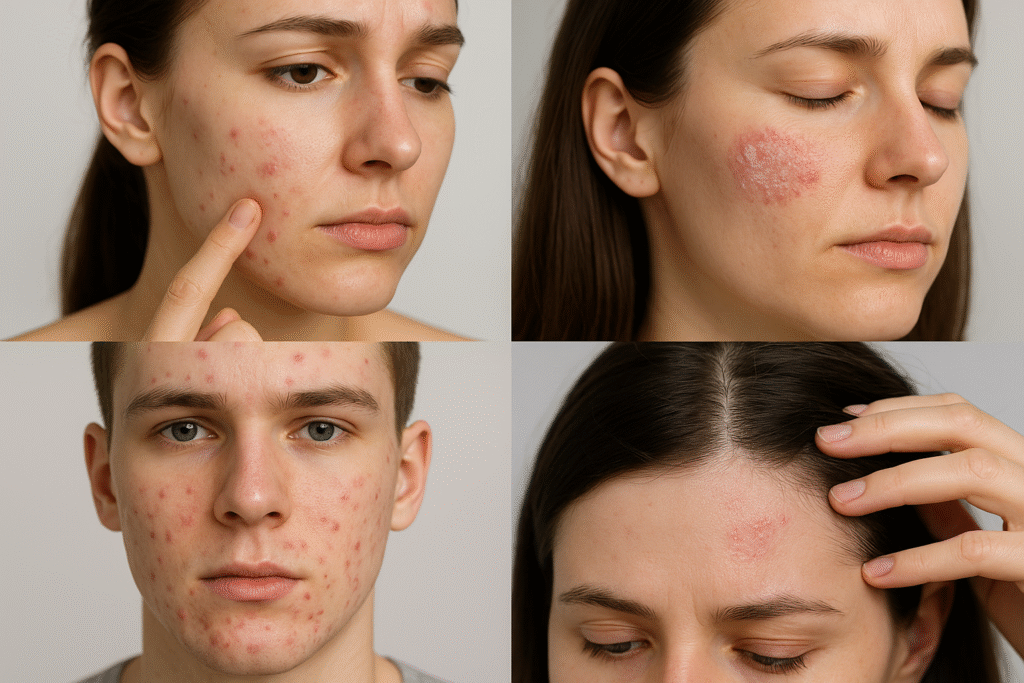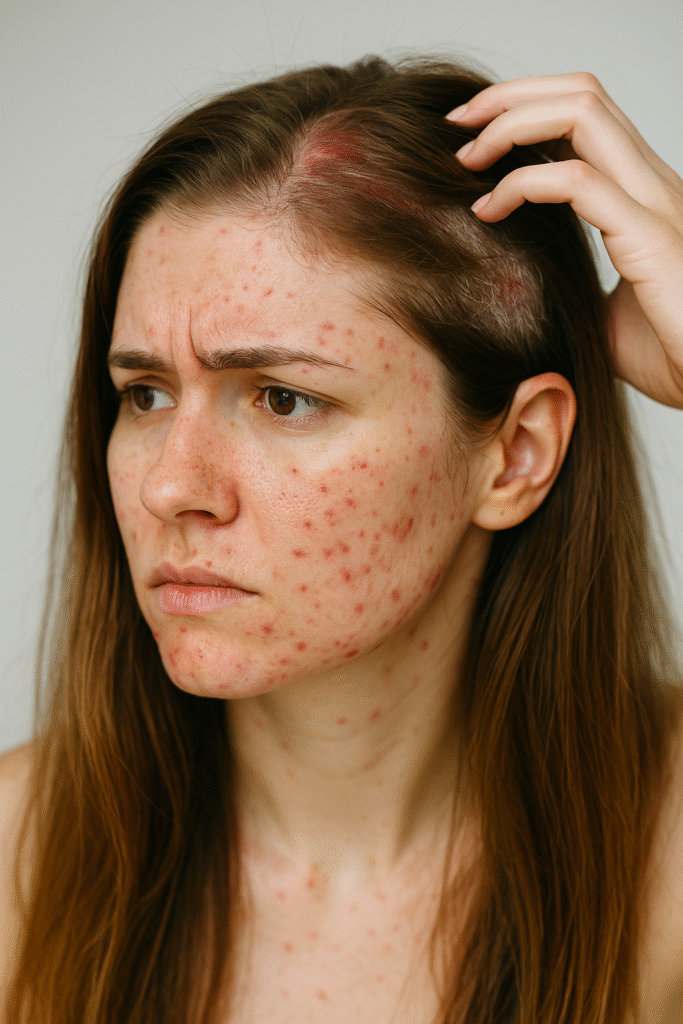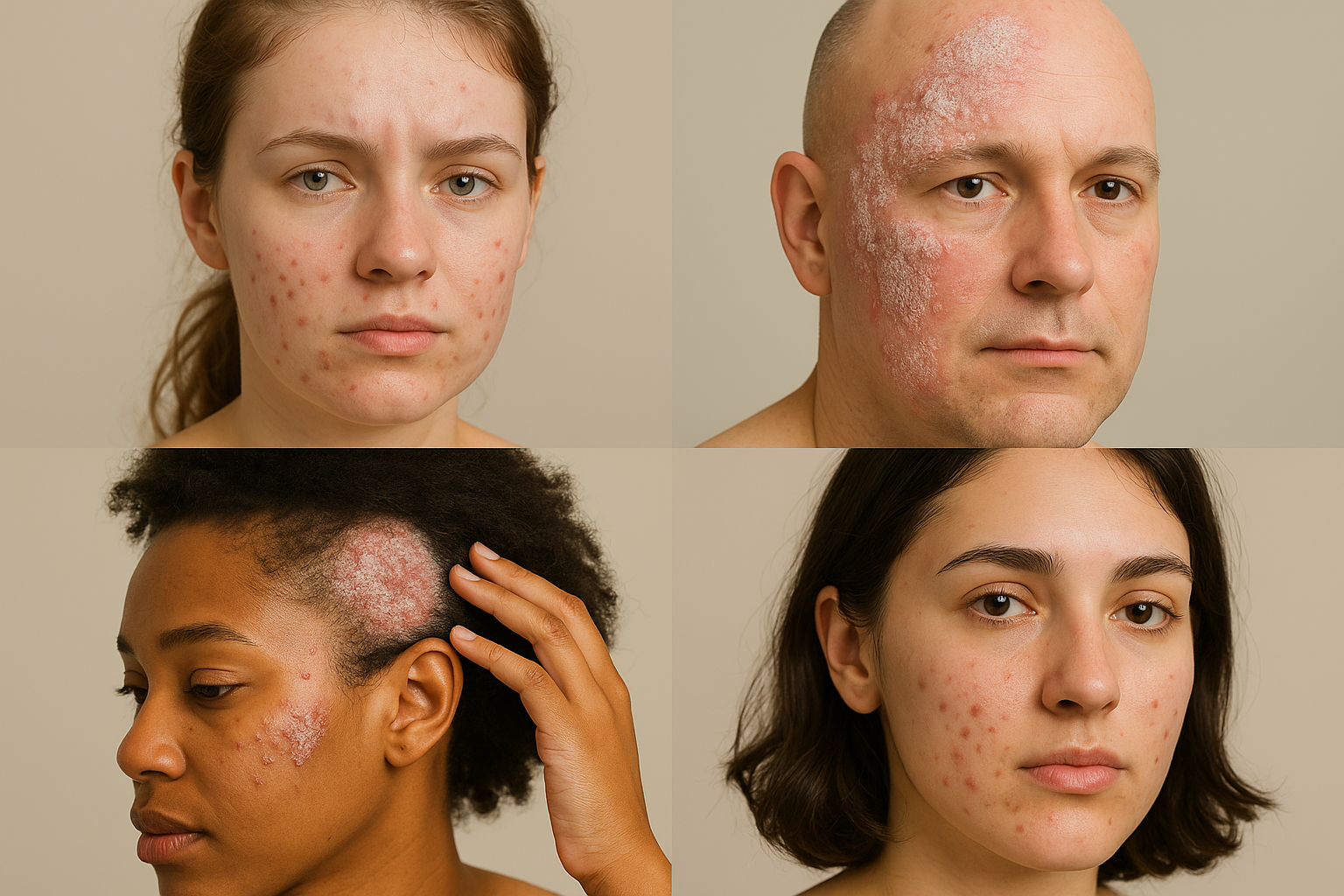Psoriasis Scalp Pimples: Chronic skin problems like pimples and psoriasis affect millions and show up everywhere — on faces, bodies, and the scalp. Queries like “pimples cream NHS” and “psoriasis treatment” reflect growing public concern and the desire for reliable, practical answers. This post pulls together the latest global, US and UK figures, explains causes, and gives safe, evidence-based tips and simple hacks you can try at home — plus clear signposts to official guidance and when to see a clinician.
Quick snapshot: how common are these problems?
- Acne / pimples is one of the world’s most common skin conditions — affecting large proportions of adolescents and many adults. Recent analyses put acne prevalence in youth and young adults very high; global studies show substantial prevalence among teens and young adults. (PubMed, pierre-fabre.com)
- In the United States, acne is the single most common skin disease, affecting up to 50 million Americans annually. (American Academy of Dermatology)
- Psoriasis affects roughly 2–3% of people worldwide, with some sources estimating tens of millions (often cited ~125 million globally; U.S. estimates commonly 7–8 million people). Many people with psoriasis also develop joint involvement (psoriatic arthritis). (National Psoriasis Foundation, globalpsoriasisatlas.org)
(If you want the short clinical takeaway: pimples are extremely common and usually benign; psoriasis is less common but can be chronic and systemic, and scalp involvement is frequent in psoriasis patients.) (nhs.uk)

How these conditions differ — plain language
Pimples / acne
- Caused by blocked hair follicles (oil + dead skin), bacteria (Cutibacterium acnes), inflammation and hormones. Lesions range from blackheads to painful cysts. Adult acne is common and can flare due to stress, hormones, meds, cosmetics or diet. (NCBI, MDPI)
Psoriasis (including scalp psoriasis and “psoriasis scalp pimples”)
- An immune-mediated disease that speeds skin cell turnover, producing thick, red, scaly patches. On the scalp, this can look like flaky, raised plaques and sometimes small pustules or “scalp pimples.” Psoriasis is chronic and may be linked to systemic inflammation; about 30% of people with psoriasis may develop psoriatic arthritis. (nhs.uk, National Psoriasis Foundation)
Why distinction matters: treatments differ. Acne creams and antibacterials help many pimples but will not control psoriasis; topical steroids, vitamin D analogues, medicated shampoos, phototherapy or systemic drugs are used for psoriasis depending on severity. Use the correct diagnosis — it changes the plan.
Official, reliable starting points (clickable)
- NHS — Acne (pimples) information & OTC cream advice (UK guidance on benzoyl peroxide etc.): https://www.nhs.uk/conditions/acne/ . (nhs.uk)
- NHS — Psoriasis: causes and treatments (UK): https://www.nhs.uk/conditions/psoriasis/ . (nhs.uk)
- American Academy of Dermatology — Skin conditions facts & treatment guidance (US) (general resource and treatment pathways): https://www.aad.org/media/stats-numbers . (American Academy of Dermatology)
- National Psoriasis Foundation — statistics and treatment info (US/global): https://www.psoriasis.org/psoriasis-statistics/ . (National Psoriasis Foundation)
- MHRA (UK) — Topical corticosteroids: safety, potency labelling & withdrawal info (important for steroid-safety): https://www.gov.uk/drug-safety-update/topical-corticosteroids-information-on-the-risk-of-topical-steroid-withdrawal-reactions . (GOV.UK)
Symptoms checklist — do these match your experience?
Acne / pimples
- Blackheads / whiteheads
- Red inflamed papules or pustules (pimples)
- Painful nodules or cysts (severe acne)
- Scarring or post-inflammatory marks
Psoriasis (incl scalp)
- Red, well-defined scaly plaques on elbows, knees, scalp, or torso
- Thick crusty scales on scalp; sometimes small pus-filled bumps (more common in some variants)
- Itching or burning; hair shed or thinned where plaques are severe
- Joint pain or stiffness (psoriatic arthritis) — see a doctor if present
If you’re seeing unusual lesions on the scalp that bleed, produce pus, or come with fever/illness — seek professional care.

Practical, evidence-based treatment options (what works and when)
For pimples / acne (mild → severe)
- OTC topical treatments: benzoyl peroxide (BPO) gels/creams, salicylic acid cleansers. NHS recommends starting with pharmacy options for mild cases — look for products containing benzoyl peroxide for spot treatment. If you search “pimples cream NHS” you’ll find the NHS page that explains how to use OTC gels and when to speak to a GP. (nhs.uk)
- Topical retinoids (prescription) — for comedonal acne and to prevent new lesions.
- Topical or oral antibiotics (when inflammation is present) — short courses to avoid resistance.
- Oral isotretinoin — for severe, scarring acne under specialist supervision.
- Lifestyle measures (see hacks below) — complementary and important.
For psoriasis (mild → severe)
- Topical therapy: vitamin D analogues (calcipotriol), topical corticosteroids — first line for limited disease. NHS details topical choices and combination creams. (nhs.uk)
- Scalp-specific treatments: medicated shampoos (coal tar, salicylic acid, ketoconazole), topical steroid lotions/foams for scalp use; combination approaches often work best. (If you have psoriasis scalp pimples, a dermatologist can help distinguish pustular variants and pick the right topical therapy.) (nhs.uk)
- Phototherapy (UVB) for widespread disease.
- Systemic therapies / biologics for moderate-to-severe psoriasis (methotrexate, cyclosporine, biologics targeting IL-17/IL-23 pathways). These are prescription specialist options and highly effective for many people. (National Psoriasis Foundation)
Important safety note about topical steroids: regulators in the UK (MHRA) have updated labelling and issued guidance about risks of prolonged strong topical steroid use and topical steroid withdrawal (TSW). Use steroids as instructed by a clinician and follow potency recommendations for body site and age. (GOV.UK, GOV.UK)
12 Simple, safe hacks you can try today
These are pragmatic, low-cost measures with evidence or strong clinical rationale.
For pimples / acne
- Use a benzoyl peroxide (BPO) spot gel for active pustules (follow NHS dosage advice). (nhs.uk)
- Gentle cleansing twice daily with a mild, non-soap cleanser — avoid over-scrubbing. (NCBI)
- Avoid heavy, comedogenic makeup; choose “non-comedogenic” labels and remove makeup every night.
- Watch hair & skin products — greasy hair products can worsen forehead/chin breakouts.
- Don’t pick or pop — reduces scarring and infection risk.
For scalp psoriasis & scalp pimples
- Medicated shampoos: rotate a coal-tar, salicylic acid or ketoconazole shampoo, following product guidance (leave on for a few minutes). For many people, shampoo + topical application helps clear scales. (nhs.uk)
- Topical scalp foams/lotions: steroid-containing foams or vitamin D analogues for scalp plaques; use exactly as prescribed. (nhs.uk)
- Warm olive oil / coconut oil softening: apply to loosen scales before shampooing (test on a small area and avoid if you have pustular signs).
- Avoid triggers: stress, smoking, certain medications and heavy alcohol intake can exacerbate psoriasis.
General skin health tips for both conditions
- Moisturize daily — healthy skin barrier reduces flares and irritation.
- Eat balanced meals & keep hydrated — while diet is not a cure, high sugar/refined carbs may worsen acne for some people; weight and metabolic control are linked to psoriasis severity. (PMC)
- Get professional input early: if OTC creams don’t help in 6–8 weeks, or if the condition is painful, spreading, or causing emotional distress, see your GP/dermatologist.
How to treat stubborn scalp pimples or confusing lesions
If you have recurrent small pustules on the scalp (pustular scalp lesions) the cause could be inflamed acne, infected hair follicles (folliculitis), pustular psoriasis, or an unrelated condition (eg, bacterial/fungal infection). A dermatologist will often:
- Examine the pattern and may take a swab/biopsy.
- Recommend a medicated shampoo plus topical antiseptic (chlorhexidine) or antibiotic/antifungal if infection is suspected.
- If pustular psoriasis is diagnosed, systemic therapy or biologic agents may be recommended.
Don’t self-treat with powerful topical steroids for long periods on the scalp without supervision — follow MHRA and NHS guidance about potency and duration. (GOV.UK, nhs.uk)
When to see a GP or dermatologist (red flags)
Seek urgent review if you notice:
- Rapidly spreading redness, swelling, fever (possible infection).
- New painful lumps or severe scalp soreness with hair loss.
- Signs of systemic illness (joint pain + skin changes → could indicate psoriatic arthritis).
- Depression or major quality-of-life impact — skin disease is linked to mental health and deserves treatment.
Interactive tools & trackers (print / screenshot / use)
1) Two-week self-care tracker (copy to phone):
| Day | Cleanse AM/PM | BPO applied? | Medicated shampoo used? | Moisturizer | Notes (pain/itch/new lesions) |
|---|
2) “Is it acne, folliculitis or psoriasis?” quick guide (for diarising prior to clinic)
- Onset age, lesion type (pustule vs thick plaque), scalp involvement, scalp scaliness, joint symptoms — fill this out and bring to your appointment; it speeds correct diagnosis.
Myths busted (short & useful)
- Myth: “Topical steroids cure psoriasis permanently.” — Fact: Steroids control inflammation but do not cure psoriasis; long-term steroid misuse carries risks. (GOV.UK)
- Myth: “All scalp flakes are dandruff.” — Fact: Flakes can be seborrheic dermatitis, psoriasis, or simple dry skin — different causes, different treatments. (nhs.uk)
Where to learn more and trusted links (UK & US)
- NHS — Acne & pimples guidance (UK) (includes OTC cream advice): https://www.nhs.uk/conditions/acne/ . (nhs.uk)
- NHS — Psoriasis (UK) (treatment options and scalp care): https://www.nhs.uk/conditions/psoriasis/ . (nhs.uk)
- American Academy of Dermatology (AAD) — acne and psoriasis pages & stats: https://www.aad.org/media/stats-numbers . (American Academy of Dermatology)
- National Psoriasis Foundation — conditions, treatment and support (US): https://www.psoriasis.org/ . (National Psoriasis Foundation)
- MHRA (UK) — Topical corticosteroids & withdrawal information: https://www.gov.uk/drug-safety-update/topical-corticosteroids-information-on-the-risk-of-topical-steroid-withdrawal-reactions . (GOV.UK)
Final checklist before you try anything new
- Read the product leaflet, follow NHS or AAD guidance for OTC creams. (nhs.uk)
- Patch test new topical medications or emollients on a small area.
- Avoid prolonged potency steroid use without medical advice (see MHRA guidance). (GOV.UK)
- If your work or relationships are impacted, prioritize a clinic appointment — skin disease is commonly treatable and help is available.
Quick summary — actionable next steps (30-day plan)
- Days 1–7: Start gentle cleansing twice daily; use moisturizer and non-comedogenic sunscreen. If you have spot pimples, begin a benzoyl peroxide spot gel (follow instructions). (nhs.uk)
- Days 8–21: Add a medicated scalp shampoo 2–3× weekly if you have scalp plaques; avoid multiple potent steroid products without review. (nhs.uk, GOV.UK)
- Day 22–30: Review progress. If no improvement, or new worrying signs, book GP/dermatology review. Track symptoms with the printable tracker above.
Disclaimer
This article is for information only and does not replace medical advice. Always consult a qualified healthcare professional for diagnosis and treatment tailored to you. The links above point to reputable sources (NHS, AAD, MHRA, National Psoriasis Foundation) for further, up-to-date official guidance. If you have severe symptoms — spreading infection, fever, or severe pain — seek urgent medical attention. All images used in this article are royalty‑free or licensed for commercial use and are provided here for illustrative purposes.
